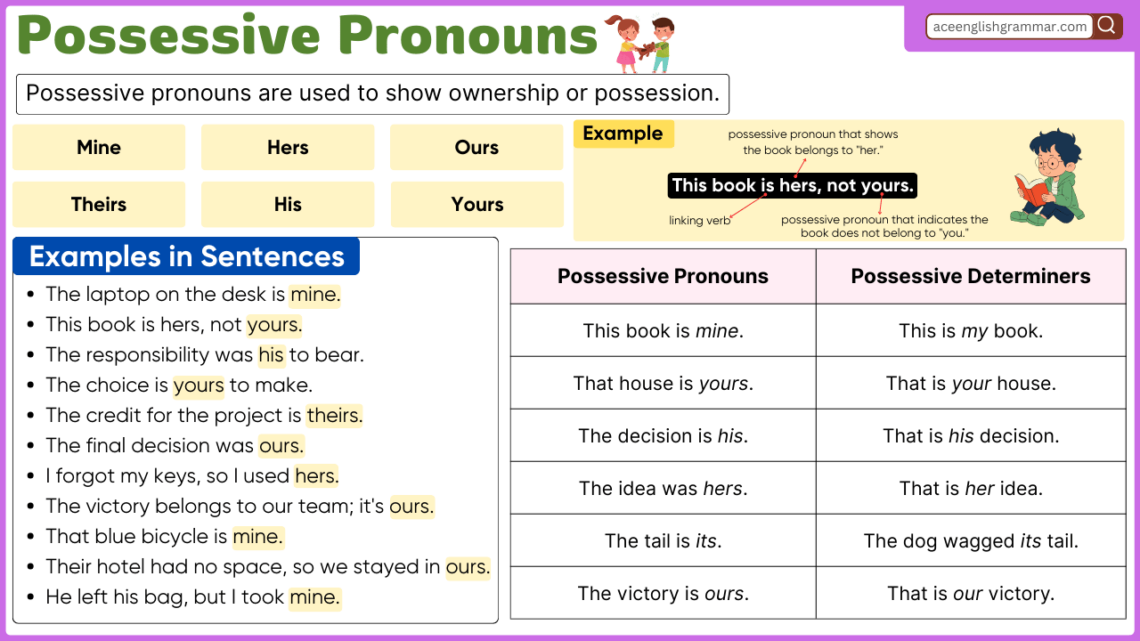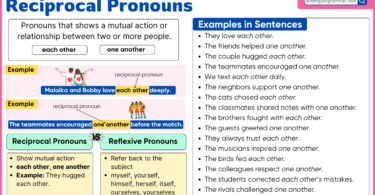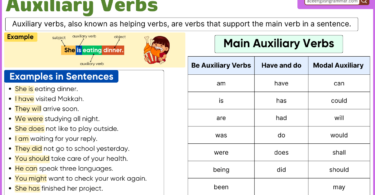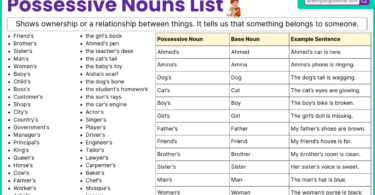Possessive pronoun show ownership and replace noun to avoid repetition. Words like mine, yours, his, hers, ours, and theirs make sentences clearer and more concise. Many learners confuse possessive pronoun with possessive adjectives, leading to common grammar mistakes. This blog post helps learn possessive pronouns with definitions, rules, and examples to improve your English skills.
A possessive pronoun shows ownership and replaces a noun to avoid repetition.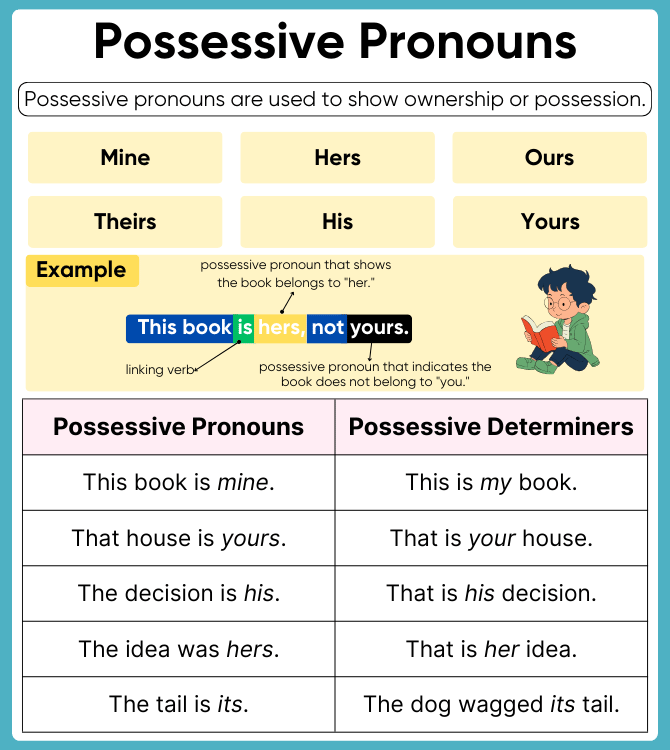
Table of Contents
List of Possessive Pronouns
These refer to possession by one person or thing.
- Mine (belonging to me)
- Yours (belonging to you)
- His (belonging to him)
- Hers (belonging to her)
- Its (belonging to it)
Plural Possessive Pronouns:
These refer to possession by more than one person.
- Ours (belonging to us)
- Yours (belonging to you all)
- Theirs (belonging to them)
Possessive Pronouns vs. Possessive Determiners
| Possessive Pronouns | Possessive Determiners |
|---|---|
| This book is mine. | This is my book. |
| That house is yours. | That is your house. |
| The decision is his. | That is his decision. |
| The idea was hers. | That is her idea. |
| The tail is its. | The dog wagged its tail. |
| The victory is ours. | That is our victory. |
| The seats are theirs. | These are their seats. |
How to Use Possessive Pronoun in Sentences
- Possessive pronouns replace a noun to show ownership.
- They are not followed by a noun.
- They must match the number (singular/plural) and gender of the noun they replace.
Rules for Using Possessive Pronouns
Do not use a noun after a possessive pronoun
- ✅ That pen is mine.
- ❌ That is mine pen.
Ensure correct agreement with the noun it replaces
- ✅ The decision was his.
- ❌ The decision was he.
Do not confuse possessive pronoun with contractions
- ✅ The dog wagged its tail.
- ❌ The dog wagged it’s tail. (“It’s” means “it is”)
Examples of Possessive Pronouns in Sentences
- The laptop on the desk is mine.
- This book is hers, not yours.
- The responsibility was his to bear.
- The choice is yours to make.
- The credit for the project is theirs.
- The final decision was ours.
- I forgot my keys, so I used hers.
- The victory belongs to our team; it’s ours.
- That blue bicycle is mine.
- Their hotel had no space, so we stayed in ours.
- He left his bag, but I took mine.
- The land was once theirs, but now it is public property.
- This seat is yours if you want it.
- The choice was entirely his to make.
- She returned my pen and took hers.
- This is not our problem; it is theirs to solve.
Importance of Learning Possessive Pronouns and Possessive Determiners
Learning about possessive pronouns and possessive determiners is important because they help us express ownership and relationships clearly in English. Without them, sentences can become confusing or awkward. Here’s why they matter:
1. Avoids Repetition
Instead of repeating a noun, possessive pronouns help us replace it, making sentences more concise.
✅ This is Aisha’s book. That is hers.
❌ This is Aisha’s book. That is Aisha’s book.
2. Clarifies Ownership
Possessive determiners indicate who something belongs to before a noun, making communication clearer.
✅ This is my pen, not your pen.
❌ This is me pen, not you pen.
3. Enhances Sentence Flow
Using possessives correctly makes writing and speech more natural.
✅ Hamza forgot his jacket at school.
❌ Hamza forgot the jacket of Hamza at school.
4. Differentiates Similar Words
Understanding the difference between possessive pronoun and possessive determiner prevents common grammar mistakes.
- Possessive determiner: This is their house.
- Possessive pronoun: This house is theirs.
Common Mistakes and How to Avoid Them
1. Using possessive pronouns with a noun
- ❌ That is mine book.
- ✅ That book is mine.
2. Confusing “its” and “it’s”
- ❌ The dog wagged it’s tail. (Incorrect: “it’s” means “it is”)
- ✅ The dog wagged its tail. (Correct)
3. Replacing a possessive pronoun with a possessive determiner
- ❌ That jacket is my.
- ✅ That jacket is mine.
Possessive Pronouns Exercises
Fill in the blanks with the correct possessive pronoun:
- This phone belongs to me. It is ____.
- That car belongs to Aisha. It is ____.
- We bought this house. It is ____.
- This decision is up to you. It is ____.
- This book is Ahmed’s. It is ____.
(Answers: mine, hers, ours, yours, his)
FAQs
A possessive pronoun is a word that replaces a noun to indicate ownership, such as mine, yours, his, hers, ours, theirs.
Possessive pronoun replace a noun (The book is mine), while possessive adjectives modify a noun (That is my book).
No, “its” is a possessive adjective. Possessive pronouns include mine, yours, his, hers, ours, theirs.
Avoid using a noun after possessive pronouns, and do not confuse “its” with “it’s.”
Yes, commonly used in both formal and informal writing to avoid repetition and clarify ownership.
Conclusion
Possessive pronouns are essential for clear communication, helping avoid redundancy while showing ownership. By understanding their usage, differentiating them from possessive adjectives, and practicing with examples, learners can improve their grammar skills. Keep practicing to master their correct usage!
Read More

